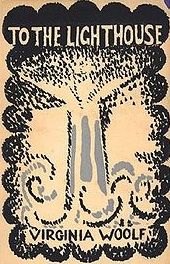
Cognition
Metaphor and Metonymy
Not just ornaments of language, ways of thinking
Posted January 25, 2013

Cover of the original publication of To the lighthouse
Metaphor and metonymy are usually regarded as figures of speech. Although the terms derive from literary theory, they might be better regarded as fundamental ways of thinking, of deep interest to psychology.
Perhaps the most important paper on metaphor and metonymy was by Roman Jakobson (1956). He proposed that all language is based on two operations. The first is selection, which occurs when someone selects a word, for instance the word “word” as the next to use in a sentence, such as this one. The second is combination, which is how one orders words in a sentence. When pressed, says Jakobson, the selection function leads to metaphor. I can select a word or concept and assert that it is something, perhaps as Hamlet says: “Denmark’s a prison.” When pressed, the combination function leads to metonymy, the juxtaposition of one word with another, or at the movies one part of an image with another. Lodge (1977) discusses these two modes as they occur in literature. Whereas metaphor seems native to poetry, metonymy seems native to novels and films. Moreover, when the issues are seen in the way that Jakobson describes, it becomes clear that the metaphorical (in which one can select one thing to stand for another) and combination (in which one can arrange things in order to associate them) are not just operations of language. They are functions of mind.
The most usually discussed form of metonymy is called synecdoche, part-for-whole. For instance, Hollywood is a synecdoche for the American movie industry; the part implies the whole. At the movies a closeup of a face is a synecdoche for the whole person. Synecdoche works (in Jakobson’s terms) because usually any part is juxtaposed with the whole, so the part can imply the whole. But the issue is far wider. With Jakobson’s idea of combination, any thing can be juxtaposed with anything else, so that a new thought can be implied for a reader or audience member. One reason why this idea is so psychologically interesting is that many mental processes work by association. If I name something, you can retrieve some aspect of its concept in your mind, and you may find it is associated with something else. The literary form, which is called metonymy, is based on the psychological process of association.
Recently, Rebecca Wells-Jopling and I (2012) proposed that metonymy is especially important in fiction because it invites an intimacy of the reader with the writer, or of the reader with a literary character, or of the reader with a book. A telling example that Rebecca had noticed was an incident in Virginia Woolf’s 1927 novel To the lighthouse. In the book, two characters, Minta and Paul were almost engaged. As they were sitting on a beach another character, Nancy, saw them there and thought they were kissing. Then—juxtaposed in the story—Minta discovers that she has lost her brooch. It had belonged to her grandmother. She searches everywhere on the beach, where she and Paul had been, and she is desperate to find it. So the scene of two people kissing on a beach is juxtaposed with the lost brooch. A reader reading thoughtfully, as Rebecca had been (though when I had read the book I had not noticed this) might think: “Why this association?” This question prompted Rebecca to ask what else might have been lost on the beach that afternoon.
In our paper we propose that, in this metonym, Virginia Woolf has taken a bit of a gamble. She has hoped that her readers might perhaps have picked up this association. As Rebecca and I discussed it, we thought perhaps that for Virginia Woolf a brooch, often used for fastening a blouse, might have had an association with undoing the blouse, and hence with sexual intimacy. If this association occurs to a reader, the reader will—as it were—enter Woolf’s mind, become intimate with her, in a small but perhaps significant way. As we say in our article:
Why would this writer juxtapose these two things? By imagining oneself into the author’s milieu (physical, emotional, and intellectual), one has a better chance of discovering the relation between the two terms of the metonym and what that relation might mean for the writer, and indeed for one’s own emotional response to the story (p. 240).
This metonym in To the lighthouse is beautiful and subtle. Virginia Woolf doesn’t mention virginity. Instead an intimacy can occur because an association for readers can mirror an association of the writer, an inward aspect of the writer’s mind.
.....
I have enjoyed writing these pieces for Psychology Today over the last two and a bit years, but I find that because I write frequently for the blog OnFiction (of which I am the manager) I can no longer keep up with writing something fresh for the Psychology Today blog once every month or six weeks. So this will be the last of my posts here. If you are interested in the psychology of fiction please visit and follow us at www.onfiction.ca
Jakobson, R. (1956). Two aspects of language and two types of aphasic disturbance. In R. Jakobson & M. Halle (Eds.), Fundamentals of language (pp. 53-83). 'S-Gravenhage: Mouton.
Lodge, D. (1977). The modes of modern writing: Metaphor, metonymy, and the typology of modern fiction. Ithaca, NY: Cornell University Press.
Wells-Jopling, R., & Oatley, K. (2012). Metonymy and intimacy. Journal of Literary Theory, 6, 235-252.
Woolf, V. (1927). To the lighthouse. London: Hogarth.
Image: Cover of the original publication of To the lighthouse, designed by Virginia Woolf’s sister Vanessa Bell

